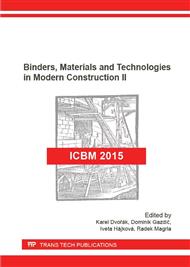[1]
ČSN EN 1015-2 – Methods of test for mortar for masonry - Part 2: Bulk sampling of mortars and preparation of test mortars, Praha, (1999).
DOI: 10.3403/01541476
Google Scholar
[2]
ČSN EN 1015-3 – Methods of test for mortar for masonry - Part 3: Determination of consistence of fresh mortar (by flow table), Praha, (1999).
DOI: 10.3403/01541440
Google Scholar
[3]
ČSN EN 1015-11 – Methods of test for mortar for masonry - Part 11: Determination of flexural and compressive strentgth of hardened mortar, Český normalizační institut, Praha, (2000).
DOI: 10.3403/01905442
Google Scholar
[4]
ČSN 72 2452 – Testing of frost resistance of mortar, Praha, (1968).
Google Scholar
[5]
ČSN 73 1326 – Resistence of cement concrete surface to water and defrosting chemicals, Praha, (1985).
Google Scholar
[6]
Davidovits, J., Geopolymer chemistry and applications, Geopolymer Institute, (2008).
Google Scholar
[7]
Shi, C., Roy, D., Krivenko, P., Alkali-activated cements and concretes, Spon press, (2006).
DOI: 10.4324/9780203390672
Google Scholar
[8]
Pacheco-Torgal, F., Castro-Gomes, J., Jalali, S.: Alkali-activated binders: A review Part 1. Historical background, terminology, reaction mechanisms and hydratation products, Construction and Building Materials, 22 (2008), pp.1305-1314.
DOI: 10.1016/j.conbuildmat.2007.10.015
Google Scholar
[9]
DIAMOND, S., DOLCH, W. L., WHITE, J. L.: Studies on Tobermorite-like calcium silicate hydrates, Purdue University, 1963, Indiana.
DOI: 10.5703/1288284313642
Google Scholar
[10]
Kearsley, E. P., Wainwright, P. J.: The effect of porosity on the strength of foamed concrete Cement and Concrete Research, 32, 2002, str. 233-239.
DOI: 10.1016/s0008-8846(01)00665-2
Google Scholar
[11]
Kumar, R., Bhattacharjee, B.: Porosity, pore size distribution and in situ strength of concrete Cement and Concrete Research, 33, 2003, str. 155- 164.
DOI: 10.1016/s0008-8846(02)00942-0
Google Scholar


